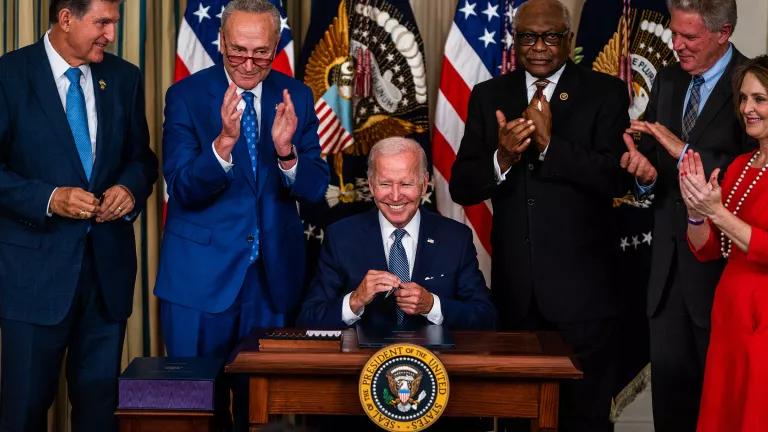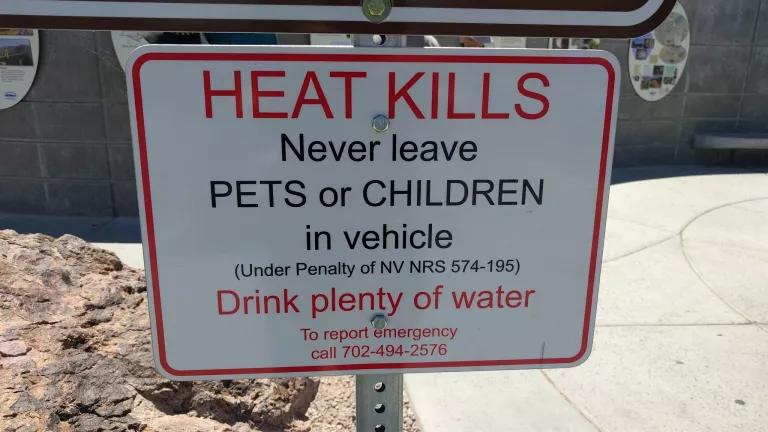Biden’s Budget Elevates Heat Protections for Workers
Budget constraints have imperiled OSHA’s mission “to ensure safe and healthful working conditions for workers” throughout its 50-year history and the president’s proposed budget starts to correct this.

A window washer in Boston.
The Biden administration’s budget request released yesterday delivers a clear message: It’s time to do something meaningful about the deadly threat of heat to America’s workers. For too long, the Occupational Safety and Health Administration (OSHA) has relied on inadequate protections to minimize preventable heat deaths, injuries, and illnesses. Congress should stand up for working people and their loved ones by fulfilling President Biden’s Fiscal Year 2023 (FY23) request for OSHA and the Department of Labor’s other worker protection agencies.
The administration proposes to increase OSHA’s overall appropriations from nearly $592 million in FY22 to more than $701 million in FY23. That’s a meaningful and historic increase for the chronically underfunded agency, even though it’s the equivalent of less than $1 for each of the 130 million workers under OSHA’s purview.
Protecting workers from heat stress and other climate-related hazards plays a starring role in the FY23 OSHA budget request—especially compared to previous fiscal years (see graph below).

What’s included in this robust proposed investment for FY23?
- About $29 million for developing multiple safety and health standards, including the heat injury and illness prevention standard initiated late last year. This 61 percent funding increase from FY22 levels is vital to OSHA’s ability to create strong, enforceable, evidence-based heat safeguards.
- About $9 million in additional funding to support the 28 states and territories with OSHA-approved State Plans. OSHA typically contributes up to half of the funding in those states for occupational health and safety plan development, operation, and enforcement. OSHA specifically mentions the need for this funding in western states that are “faced with protecting workers from heat stress and other climate-related illnesses and injuries from high temperatures, wildfires, and other hazards.” Importantly, state and local government workers are protected by occupational safety and health law only in certain State Plan states. In states and territories without State Plans, those workers fall through the cracks.

Workers clearing debris from a stream in southern California.
- Close to $14 million for Susan Harwood Training Grants, including those related to workplace heat. These competitive grants are used to increase knowledge of workplace hazards, workers’ rights, and employer responsibilities, particularly in underserved communities.
- 45 new Compliance Assistance Specialist positions, to increase outreach around voluntary programs such as OSHA’s WATER. REST. SHADE. campaign and to provide free guidance to small businesses, faith-based groups, and others on how to comply with OSHA standards.
- $1.5 million for litigation support services, including for heat stress cases. Employers regularly contest OSHA citations in court even though the penalties for violations are pitifully low. The agency likely will face litigation pressure as it steps up heat enforcement under existing safeguards and works to develop new ones.
Budget constraints have imperiled OSHA’s mission “to ensure safe and healthful working conditions for workers” throughout its 50-year history and the president’s proposed budget starts to correct this. Threats to workers—and the pressures on OSHA—have only intensified in recent years due to the COVID-19 pandemic and climate-related hazards such as extreme heat. Congress should seize this opportunity to protect worker health and safety by fulfilling President Biden’s FY23 budget request for OSHA and its sister agencies at the Department of Labor.




